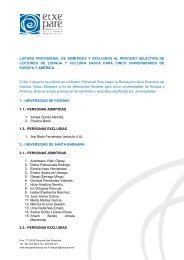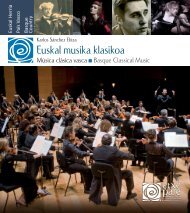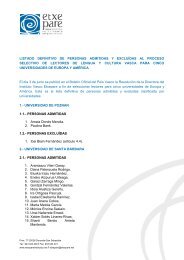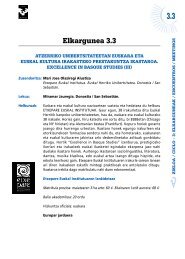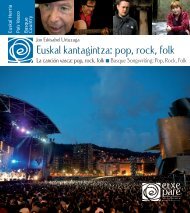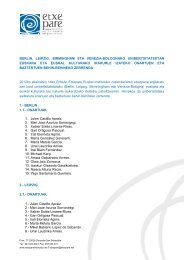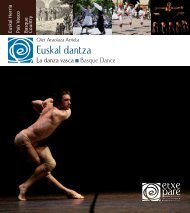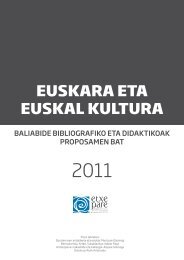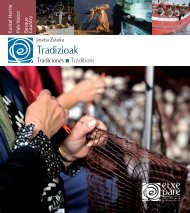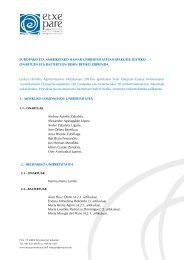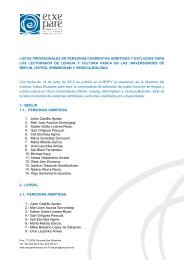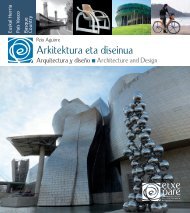XX. mendeko euskal literatura - Etxepare, Euskal Institutua
XX. mendeko euskal literatura - Etxepare, Euskal Institutua
XX. mendeko euskal literatura - Etxepare, Euskal Institutua
You also want an ePaper? Increase the reach of your titles
YUMPU automatically turns print PDFs into web optimized ePapers that Google loves.
su trabajo irradiaba una gran fuerza. Tras la guerra,<br />
sin embargo, los ánimos decayeron. De hecho, los<br />
poetas de la posguerra miraban con nostalgia a la<br />
ilusión, la fuerza, la ironía, la variedad y la vivacidad<br />
de los planteamientos del Renacimiento. Los poetas<br />
de 1942-1963 se centraron en reflejar la situación del<br />
euskera y la cultura vasca. Sus poemas son muestra<br />
de la angustia y la negatividad del momento, aunque<br />
evitan caer en la desesperación.<br />
Durante la posguerra, Telésforo Monzón y Jokin Zaitegi<br />
publicaron sus primeras obras en el exilio. Algunos<br />
poetas continuaron con su labor sin abandonar<br />
el país, como sucedió con Salbatore Mitxelena, Nemesio<br />
Etxaniz, Juan San Martin Otsalar y J. I. Goikoetxea<br />
Gaztelu en el caso del País Vasco peninsular. En<br />
el País Vasco continental son de destacar J. Diharce<br />
Iratzeder y M. Erdozaintzi-Etxart. En este contexto<br />
hizo su aparición en París el heterodoxo Jon Mirande.<br />
Cabe reseñar que a excepción de Monzón, Otsalar<br />
y Mirande, el resto de autores que mantuvieron<br />
la llama de la poesía vasca viva durante el ambiente<br />
de represión de la posguerra eran miembros de diferentes<br />
órdenes religiosas. Ello explica la perspectiva<br />
y temática religiosa de su obra.<br />
La obra de Jon Mirande (París, 1925-1972) se dio a<br />
conocer a través de las revistas Egan, Euzko-Gogoa<br />
e Igela. Entre 1950 y 1952 el autor trató de publicar<br />
el poemario titulado Ihun-Argi, pero el proyecto no<br />
salió adelante. Tras la muerte Mirande, han visto la<br />
luz varias recopilaciones de su obra: Orhoituz (1976),<br />
editado por A. Eguzkitza; Ene jainko eidol zaharra,<br />
lur! (1984), edición de Xabier Olarra; Poemak (1950-<br />
1966) (1984), edición de Txomin Larrea e Ilhun-Argiak.<br />
Claroscuros (EHU, 1993), editado por Iñaki Aldekoa<br />
y Eduardo Gil Bera. La obra de Mirande tiende<br />
a los extremos (la prostitución, el alcohol, la pedofilia,<br />
la homosexualidad...) y a la utopía. Sarrionandia<br />
sitúa la poesía de Mirande cerca del romanticismo<br />
intelectual de Poe y Baudelaire; dicha poesía da preferencia<br />
al uso de la razón, al cálculo y al método,<br />
full of hope and good intentions, looking towards the<br />
future, and their work radiated with great energy. Following<br />
the war, however, this vitality faded. Indeed,<br />
post-war poets looked back nostalgically at the spirit,<br />
strength, irony, diversity and vivacity of the renaissance<br />
work. Poets in the period 1942-1963 focused<br />
on reflecting the situation of Euskara and Basque<br />
culture. Their poems are examples of the pain and<br />
negativity of the moment, although they manage<br />
to not fall into desperation. In the post-war period<br />
Telésforo Monzón and Jokin Zaitegi published their<br />
first works in exile. Some poets continued their work<br />
without abandoning the country, as was the case<br />
with Salbatore Mitxelena, Nemesio Etxaniz, Juan<br />
San Martin “Otsalar” and J. I. Goikoetxea “Gaztelu”<br />
in the peninsular Basque Country. In the continental<br />
Basque Country J. Diharce “Iratzeder” and M.<br />
Erdozaintzi-Etxart stood out. In this context, the heterodox<br />
figure of Jon Mirande also emerged in Paris.<br />
One should also mention that, with the exception<br />
of Monzón, “Otsalar” and Mirande, the rest of the<br />
authors that kept the flame of Basque poetry alive in<br />
the repressive environment of the post-war era were<br />
members of different religious orders. This explains<br />
the religious perspective and content of their work.<br />
The work of Jon Mirande (Paris, 1925-1972) became<br />
known through the pages of the journals Egan,<br />
Euzko-Gogoa and Igela. In the period 1950-52 this<br />
author tried to publish a book of poems titled Ihun-<br />
Argi, but the project was never realised. Several collections<br />
of his work were, though, published posthumously:<br />
Orhoituz (1976), edited by A. Eguzkitza; Ene<br />
jainko eidol zaharra, lur! (1984), edited by X. Olarra;<br />
Poemak (1950-1966) (1984), edited by Txomin Larrea<br />
and Ilhun-Argiak. Claroscuros (1993), edited by I. Aldekoa<br />
and E. Gil Bera. Mirande’s work tends towards<br />
extremes (addressing subjects like prostitution, alcohol,<br />
paedophilia and homosexuality) and utopian<br />
visions. For Sarrionandia, Miarnde’s poetry was similar<br />
to the intellectual romanticism of Poe and Bau-<br />
53



